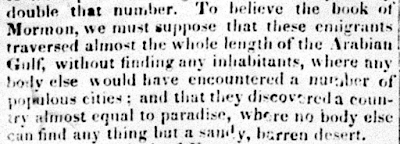One of the earliest criticisms of the Book of Mormon anticipates some of the most recent. For example, a modern critic writing for Faith Promoting Rumor finds it improbable that an ancient place like Bountiful, a rare green treasure among the vast deserts of Arabia, could possibly have been uninhabited as Nephi's record implies (details of the criticism and my response are in "Joseph and the Amazing Technicolor Dream Map, Part 2" as well as Parts 1 and 3).
Obviously, a place with fresh water, abundant fruit, etc., would attract a large population, right? This argument does not require the benefits of recent scholarship from someone with an advanced degree from Harvard, for it was one of the earliest recorded objections to the content of the Book of Mormon. Just a few months after the Book of Mormon was published, a writer under the name of "Gimel" wrote a critical review of the Book of Mormon for The Christian Watchman, vol. 12, no. 40 (1831). One of his most specific and pointed arguments against it involved the implausibility of a place like Bountiful existing, especially an uninhabited place like that:
To believe the book of Mormon, we must suppose that these emigrants traversed almost the whole length of the Arabian Gulf … and that they discovered a country almost equal to paradise, where no body else can find any thing but a sandy, barren desert.Kudos to Book of Mormon Central for their recent article on Bountiful in the Arabian Peninsula that called this 1831 criticism to my attention. You can see images of the original article on a page from a BYU collection of early materials related to the Book of Mormon.
Yes, a place like Bountiful has long been thought to be implausible, and the idea such a place, if it existed in Arabia, could remain uninhabited seems wildly implausible -- or rather, I should say seemed implausible, until the day that a weary Warren Aston and his 14-year-old daughter made a surprising discovery of a verdant, green, and surprisingly uninhabited spot on the east coast of Oman. As described in Warren's brilliant DVD, Lehi in Arabia, they set foot there at what seemed like an unpromising spot at the suggestion of Warren's daughter as he was about to give up after a long day of cruising in a small boat along the coast of Oman.
He had been looking for potential Bountiful candidates that fit Nephi's description of being nearly due east from the recently identified ancient candidate for Nahom. No candidate they had looked at in previous work met the 12 criteria he had extracted through careful analysis of Nephi's writings. He felt there had to be something better and, using his own finances, began searching.
When he yielded to his daughter's suggestion to stop and explore one last spot, it was only after getting out of the boat that they were able to see over the natural sand bar that blocked a view of the very plush parts of Khor Kharfot from the view of travelers on the sea.
Further investigation would show why the miraculously green mouth of the long wadi known as Wadi Sayq has been relatively uninhabited over the centuries: it hidden by the terrain around it, making it hard to recognize as anything special from the sea and making access by land very difficult unless you know which wadi to descend about 25 miles inland. It truly is a miraculous gem, almost as if designed to be uninhabited in preparation for a prophet and his family one one of the greatest treks in the scriptures.
The miracle of the Nahom discoveries, including hard archaeological evidence confirming the existence of the NHM tribe in the right region and time to support the plausibility of Nephi's record, is now being treated by some critics as a simple matter of Joseph plagiarizing the account by noticing the name Nehhem on a rare European map, in spite of the improbability of having ever seen it. But the hard evidence for a plausible Bountiful candidate, indeed, an uninhabited Bountiful candidate, almost exactly "due east" of Nahom, and accessible from inland as described, and meeting all other criteria one can extract from the Book of Mormon text, is a matter that is not so easily dismissed as the inevitable result of getting a brief glimpse at somebody's map.
There is no Bountiful to be plucked on those maps. What scholars might have known of Felix Arabia (south of Nahom) was not adequate to guide Joseph's placement and description of Bountiful. If the critics cannot do better than simply remind us why a place like Bountiful is not likely to be uninhabited, when the leading candidate for Bountiful, drenched in layers of surprising plausibility, is still to this day largely uninhabited in spite of fresh water, fruit, etc., then they are not really engaged in a meaningful debate of the evidence. May the discussion of Book of Mormon evidence do more to consider the strengths of the evidence for plausibility rather than repeat ancient criticisms that have been thoroughly addressed.
The account of Lehi's trek through the Arabian Peninsula was downright laughable in 1830. Today it is one of the most interesting strengths of the Book of Mormon in terms of evidence for plausibility. How things have changed!
Continue reading at the original source →





